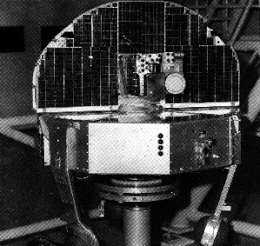 The third Orbiting Solar Observatory, OSO 3, showing its "Sail" (upper), carrying solar experiments pointed at the Sun, and its rotating "Wheel" (lower), carrying two sky-scanning survey instruments: the UCSD hard X-ray experiment, and the MIT gamma-ray telescope | |
| Mission type | Solar physics |
|---|---|
| Operator | NASA |
| COSPAR ID | 1967-020A |
| SATCAT no. | 02703 |
| Mission duration | 2 years, 8 months |
| Spacecraft properties | |
| Manufacturer | BBRC |
| Launch mass | 281 kilograms (619 lb) |
| Start of mission | |
| Launch date | March 8, 1967, 16:19:00 UTC |
| Rocket | Delta C |
| Launch site | Cape Canaveral LC-17A |
| End of mission | |
| Last contact | November 10, 1969 |
| Decay date | April 4, 1982 |
| Orbital parameters | |
| Reference system | Geocentric |
| Regime | Low Earth |
| Eccentricity | 0.002164 |
| Perigee altitude | 534 kilometers (332 mi) |
| Apogee altitude | 564 kilometers (350 mi) |
| Inclination | 32.87 degrees |
| Period | 95.53 minutes |
| Mean motion | 15.07 |
| Epoch | May 8, 1967, 11:19:00 UTC[1] |
OSO 3 (Orbiting Solar Observatory 3), or Third Orbiting Solar Observatory[2][3] (known as OSO E2 before launch) was launched on March 8, 1967, into a nearly circular orbit of mean altitude 550 km, inclined at 33° to the equatorial plane. Its on-board tape recorder failed on June 28, 1968, allowing only the acquisition of sparse real-time data during station passes thereafter; the last data were received on November 10, 1969. OSO 3 reentered the Earth's atmosphere and burned up on April 4, 1982.
Like all the American Orbiting Solar Observatory (OSO) series satellites, it had two major segments: one, the "Sail", was stabilized to face the Sun, and carried both solar panels and Sun-pointing experiments for solar physics. The other, "Wheel" section, rotated to provide overall gyroscopic stability and also carried sky scanning instruments that swept the sky as the wheel turned, approximately every 2 seconds.
- ^ "NASA - NSSDCA - Spacecraft - Trajectory Details". nssdc.gsfc.nasa.gov. Retrieved May 2, 2018.
- ^ NASA GSFC X-ray Astronomy Satellites and Missions
- ^ [1] GSFC HEASARC "The Third Orbiting Solar Observatory (OSO-3)"